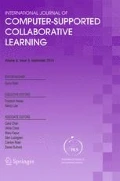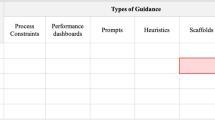Abstract
In this paper, we present the results of an exploratory study into the relationship between student self-efficacy and guidance use in a Multi-User Virtual Environment (MUVE) science curriculum project. We describe findings from a sample of middle school science students on the combined impact on learning of student self-efficacy in scientific inquiry and use of individualized guidance messages, and on the interplay between levels of self-efficacy and use of an embedded guidance system in an educational MUVE. Results from our study showed that embedded guidance was associated with improved learning outcomes for learners across a spectrum of self-reported efficacy in science. However, we also found that learners with low levels of initial self-efficacy in science viewed fewer guidance messages than their higher efficacy peers, and did not perform as well as their higher efficacy peers regardless of guidance use level. At the same time, outcomes for low self-efficacy students who used the guidance system heavily were raised to the level of high self-efficacy students who did not use the system.





Similar content being viewed by others
References
American Association of University Women (2000). Tech-savvy: Educating girls in the new computer age. Washington, DC: AAUW Educational Foundation.
Bandura, A. (1977). Self-efficacy: towards a unifying theory of behavioural change. Psychological Review, 84, 191–215.
Bandura, A. (1986). Social foundations of thought and action: A social cognitive theory. Englewood Cliffs, NJ: Prentice Hall.
Barab, S., Arici, A., & Jackson, C. (2005a). Eat your vegetables and do your homework: a design based investigation of enjoyment and meaning in learning. Educational Technology, 45(1), 15–20.
Barab, S., Sadler, T., Heiselt, C., Hickey, D., & Zuiker, S. (2007). Relating narrative, inquiry, and inscriptions: supporting consequential play. Journal of Science Education and Technology, 16(1), 59–82.
Barab, S., Thomas, M., Dodge, T., Carteaux, R., & Tuzan, H. (2005b). Making learning fun: Quest Atlantis, a game without guns. Educational Technology Research & Development, 53(1), 86–107.
Baylor, A. (2000). Beyond butlers: intelligent agents as mentors. Journal of Educational Computing Research, 22(4), 373–382.
Bers, M. U. (1999). Zora: A graphical multi-user environment to share stories about the self. In C. Hoadley & J. Roschelle (Eds.), Computer support for collaborative learning: Designing new media for a new millennium. Proceedings of CSCL 1999. Palo Alto, CA, USA.
Bers, M. U., & Cassell, J. (1998). Interactive storytelling systems for children: using technology to explore language and identity. Journal of Interactive Learning Research, 9(2), 183–215.
Bong, M. (2002). Measuring self-efficacy: multitrait–multimethod comparison of scaling procedures. Applied Measurement in Education, 15(2), 143–171.
Bruckman, A. (1996). Finding one's own space in cyberspace. Technology Review, 99(1), 48–54.
Bruckman, A. (2000). Uneven achievement in a constructivist learning environment. Paper presented at the International Conference on Learning Sciences, Ann Arbor, MI.
Bruckman, A., Jensen, C., & DeBonte, A. (2002). Gender and programming achievement in a CSCL environment. In G. Stahl (Eds.), Computer support for collaborative learning: Foundations for a CSCL community. Proceedings of CSCL 2002. Boulder, CO, USA. Mahwah, NJ: Erlbaum.
Clarke, J., & Dede, C. (2005). Making learning meaningful: An exploratory study of using multi-user environments (MUVEs) in middle school science. Paper presented at the American Educational Research Association Conference, Montreal, Canada.
Clarke, J., Dede, C., Ketelhut, D. J., & Nelson, B. (2006). A design-based research strategy to promote scalability for educational innovations. Educational Technology, 46(3), 27–36.
Corbit, M., & DeVarco, B. (2000). SciCentr and BioLearn: Two 3D implementations of CVE science museums. Paper presented at the Third International Conference on Collaborative Virtual Environments, San Francisco.
Dede, C., Ketelhut, D. J., & Ruess, K. (2002). Motivation, usability, and learning outcomes in a prototype museum-based multi-user virtual environment. In P. Bell, R. Stevens & T. Satwicz (Eds.), Keeping learning complex: The proceedings of the Fifth International Conference of the Learning Sciences. Mahwah, NJ: Erlbaum.
Flum, H., & Kaplan, A. (2006). Exploratory orientation as an educational goal. Educational Psychologist, 41(2), 99–110.
Fraser, B. (1981). TOSRA: Test of science related attitudes. Hawthorne, VIC: Australian Council for Educational Research.
Galarneau, L., & Zibit, M. (2007). Online games for 21st century skills. In D. Gibson, C. Aldrich & M. Prensky (Eds.), Games and simulations in online learning: Research and development frameworks (pp. 59–88). Hershey, PA: Idea Group.
Gee, J. P. (2003). What video games have to teach us about learning and literacy. New York, NY: Palgrave.
Grigg, W., Lauko, M., & Brockway, D. (2006). The nation's report card: Science 2005 (NCES 2006–466). U.S. Department of Education, National Center for Education Statistics. Washington, D.C.: U.S. Government Printing Office.
Hannafin, M. J., Hannafin, K. M., Land, S. M., & Oliver, K. (1997). Grounded practice and the design of constructivist learning environments. Educational Technology Research & Development, 45(3), 101–117.
Jonassen, D. H. (1991). Objectivism versus constructivism: do we need a new philosophical paradigm? Educational Technology Research & Development, 39(3), 5–14.
Jonassen, D. H., Peck, K. L., & Wilson, B. G. (1999). Learning with technology: A constructivist perspective. Upper Saddle River, NJ: Merrill, Prentice Hall.
Jonassen, D. H., Wilson, B. G., Wang, S., & Grabinger, R. S. (1993). Constructivist uses of expert systems to support learning. Journal of Computer-Based Instruction, 20(3), 86–94.
Ketelhut, D. J. (2005). Assessing science self-efficacy in a virtual environment: A Measurement Pilot. Paper presented at the National Association of Research in Science Teaching Conference, Dallas, April.
Ketelhut, D. J. (2007). The impact of student self-efficacy on scientific inquiry skills: an exploratory investigation in River City, a multi-user virtual environment. The Journal of Science Education and Technology, 16(1), 99–111.
Ketelhut, D. J., Clarke, J., Dede, C., Nelson, B., & Bowman, C. (2005). Extending library services through emerging interactive media. Knowledge Quest, 34(1), 29–32.
Kirschner, P. A., Sweller, J., & Clark, R. E. (2006). Why minimal guidance during instruction does not work: an analysis of the failure of constructivist, discovery, problem-based, experiential, and inquiry-based teaching. Educational Psychologist, 41(2), 75–86.
Lebow, D. (1993). Constructivist values for instructional systems design: five principles toward a new mindset. Educational Technology Research and Development, 41(3), 4–16.
Lent, R. W., Brown, S. D., & Larkin, K. C. (1984). Relation of self-efficacy expectations to academic achievement and persistence. Journal of Counseling Psychology, 31, 356–362.
Lent, R. W., Brown, S. D., & Larkin, K. C. (1986). Self-efficacy in the prediction of academic performance and perceived career options. Journal of Counseling Psychology, 33, 265–269.
Lent, R. W., & Hackett, G. (1987). Career self-efficacy: empirical status and future directions. Journal of Vocational Behavior, 30, 347–382.
Leslie, L. L., McClure, G. T., & Oaxaca, R. L. (1998). Women and minorities in science and engineering: a life sequence analysis. The Journal of Higher Education, 69(3), 239–276.
Lim, C. P., Nonis, D., & Hedberg, J. (2006). Gaming in a 3D multiuser virtual environment: engaging students in science lessons. British Journal of Educational Technology, 37(2), 211–231.
Lopez, F. G., & Lent, R. W. (1992). Sources of mathematics self-efficacy in high school students. The Career Development Quarterly, 41, 3–12.
Mayer, R. E. (2004). Should there be a three-strikes rule against pure discovery learning? The case for guided methods of instruction. Educational Psychologist, 59, 14–19.
Midgley, C., Maehr, M. L., Hruda, L. Z., Anderman, E., Anderman, L., Freeman, K. E., Gheen, M., Kaplan, A., Kumar, R., Middleton, M. J., Nelson, J., Roeser, R., & Urdan, T. (2000). Manual for the Patterns of Adaptive Learning Scales (PALS). Ann Arbor, MI: University of Michigan.
National Research Council (1996). National science education standards: Observe, interact, change, learn. Washington, D.C.: National Academy Press.
Nelson, B. (2007). Exploring the use of individualized, reflective guidance in an educational multi-user virtual environment. The Journal of Science Education and Technology, 16(1), 83–97.
Nelson, B., Ketelhut, D. J., Clarke, J., Bowman, C., & Dede, C. (2005). Design-based research strategies for developing a scientific inquiry curriculum in a multi-user virtual environment. Educational Technology, 45(1), 21–34.
Nelson, B., Ketelhut, D. J., Clarke, J., Dieterle, E., Dede, C., & Erlandson, B. (2007). Robust design strategies for scaling educational innovations: The River City case study. In B. E. Shelton & D. A. Wiley (Eds.), The design and use of simulation computer games in education (pp. 219–242). Rotterdam: Sense.
Pajares, F. (1996). Self-efficacy beliefs in academic settings. Review of Educational Research, 66, 543–578.
Pajares, F. (1997). Current directions in self-efficacy research. In M. Maehr & P. R. Pintrich (Eds.), Advances in motivation and achievement (Vol. 10 (pp. 1–49). Greenwich, Ct: JAI.
Pajares, F. (2000). Schooling in America: Myths, mixed messages, and good intentions (Lecture). Cannon Chapel: Emory University.
Pajares, F. (2002). Overview of social cognitive theory and of self-efficacy. Retrieved September 5, 2007, from http://www.emory.edu/EDUCATION/mfp/eff.html.
Pajares, F., Cheong, Y. F., & Oberman, P. (2004). Psychometric analyses of computer science help-seeking scales. Educational and Psychological Measurement, 64, 496–513.
Perkins, D. N. (1991). Technology meets constructivism: do they make a marriage? Educational Technology, 31(5), 18–23.
Pintrich, P. R., & Groot, E. V. D. (1990). Motivational and self-regulated learning components of classroom academic performance. Journal of Educational Psychology, 82, 33–40.
Puntambekar, S., & Hübscher, R. (2005). Tools for scaffolding students in a complex learning environment: what have we gained and what have we missed? Educational Psychologist, 40(1), 1–12.
Schunk, D. H. (1983). Ability versus effort attributional feedback: differential effects on self-efficacy and achievement. Journal of Educational Psychology, 75, 848–856.
Schunk, D. H. (1987). Peer models and children’s behavioural change. Review of Educational Research, 57, 149–174.
Shaffer, D. W. (2006). How computer games help children learn. New York: Palgrave.
Slator, B. M., Hill, C., & Del Val, D. (2004). Teaching computer science with virtual worlds. IEEE Transactions on Education, 47(2), 269–275.
Socially-Responsive Design Group (2004). Creating a socially-responsive play space for learning: Something for girls and boys. Paper presented at the Annual Meeting of the American Educational Research Association, San Diego, CA.
Stajkovic, A. D., & Luthans, F. (1998). Self-efficacy and work-related performance: a meta-analysis. Psychological Bulletin, 124, 240–261.
Steinkuehler, C. A. (2004). Learning in massively multiplayer online games. In Y. B. Kafai, W.A. Sandoval, N. Enyedy, A. S. Nixon & F. Herrera (Eds.), Proceedings of the Sixth International Conference of the Learning Sciences (pp. 521–528). Mahwah, NJ: Erlbaum.
Steinkuehler, C., & Chmiel, M. (2006). Fostering scientific habits of mind in the context of online play. In S. A. Barab, K. E. Hay, N. B. Songer & D. T. Hickey (Eds.), Proceedings of the International Conference of the Learning Sciences (pp. 723–729). Mahwah NJ: Erlbaum.
Zimmerman, B. J., & Bandura, A. (1994). Impact of self-regulatory influences on writing course attainment. American Educational Research Journal, 31, 845–862.
Author information
Authors and Affiliations
Corresponding author
Appendix
Appendix
Self-efficacy in Scientific Inquiry
I can write an introduction to a lab report.
I can use graphs to show what I found out in my experiment.
It is hard for me to write a report about an experiment.
I know how to use the scientific method to solve problems.
It is hard for me to look at the results of an experiment and tell what they mean.
When I do an experiment, it is hard for me to figure out how the data I collected answers the question.
When I do my work in science class, I am able to find the important ideas.
Once I have a question, it is hard for me to design an experiment to test it.
I can design an experiment to test my ideas.
I have trouble figuring out the main ideas of what my science teacher is teaching us.
I can tell the difference between observations and conclusions in a story.
It is easy for me to make a graph of my data.
Rights and permissions
About this article
Cite this article
Nelson, B.C., Ketelhut, D.J. Exploring embedded guidance and self-efficacy in educational multi-user virtual environments. Computer Supported Learning 3, 413–427 (2008). https://doi.org/10.1007/s11412-008-9049-1
Received:
Accepted:
Published:
Issue Date:
DOI: https://doi.org/10.1007/s11412-008-9049-1




